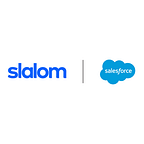Behind the Scenes: Get Started with Generative AI
Get a backstage look at a popular Dreamforce 2023 presentation, including key takeaways for implementing GenAI in your business.
Since the rise of generative AI, every technology platform on the market has been scrambling to make AI the center of their architecture and offerings. My colleague Dave Dixon and I were fortunate enough to present about how to get started with this revolutionary technology at Dreamforce 2023, and our presentation came on the heels of Marc Benioff’s keynote, which highlighted several of the numerous products that Salesforce plans to release in the next year around AI (Einstein Copilot, Einstein Studio, Tableau GPT and Pulse, to name a few) and the reimagining of Salesforce as an AI + data + CRM platform.
By doubling down on Data Cloud — which allows customers to harmonize their customer data within Salesforce — the possibilities are endless for how to build AI on top of this rich data to provide insights and next steps in service, sales, marketing, and many other clouds.
Overview of generative AI
AI is already all around us with search engines, personalized feeds on social media, chatbots, personalized recommendations on our favorite streaming systems, etc. At its core, it is the science of teaching a machine how to perform tasks and make decisions that normally require human intelligence. The introduction of GenAI models has brought AI front and center and been the catalyst for an AI revolution, but it is not the AI to end all AI. We sometimes get asked if ChatGPT and other GenAI tools replace all other AI and answer all business questions moving forward. The answer is no, and it is important to understand where GenAI sits in the landscape of AI and machine learning.
GenAI is a type of artificial intelligence that builds on deep learning neural nets. In the case of large language models (LLMs), the models are trained on vast quantities of text data and essentially learn language by creating connections between the meaning of words and words in context. These models cannot accurately tell you the probability that a customer is going to attrit based on their recent experiences (that would be another kind of machine learning model), but they could provide insights based on those customer predictions and other customer data to help you understand the why of attrition and potentially what to do about it. These models push way beyond what we have previously seen for personalization in all applications, and the combined power of having a holistic view of your customer, making predictions about your customer from machine learning algorithms, and then asking an LLM to summarize that customer and create a personalized, interactive experience for them is the power of creating an integrated AI/ML solution that starts with unified customer data.
Salesforce GenAI use cases
Within the Salesforce world, the Service, Sales, and Marketing Clouds quickly come to mind as areas where users can gain valuable time and increase positive customer interactions using GenAI. For example:
- Service: Chat agent support and personalization in response to customers on service calls
- Sales: Creation of lead emails, guidance on next steps for deal success, help with presentations
- Marketing: Subject and message content
Considerations when implementing GenAI for your business
Models must be trained on unbiased, high-quality data, as their results are only as good as the data they are trained on. Because LLMs are trained on a wide range of information, we need to look for bias and misinformation in model responses. The reality is that the majority of organizations will rely on LLMs available through tools and vendors and fine-tune those models for their data and business purposes. If we’re using an LLM to talk to our customers, we need guardrails in place to ensure that the model stays on topic and on brand for our company.
Also, we don’t want our proprietary data to be used for model training (including prompts and the data we use to fine-tune the model) so there needs to be a security layer in place. Salesforce has introduced the Einstein Trust Layer, which allows for zero retention of customer data in LLM models and masks the data. Toxicity of responses is monitored, as well as bias. With AI we should always think forward to what the consequences will be if a model is wrong or gives false or off-topic output.
Resources
By now, I imagine most readers have played around with some form of GenAI, maybe in the form of asking ChatGPT questions. If you haven’t, this is the best way to start trying out the technology to understand the implications and potential use cases for your business. By understanding its value in our everyday lives, we can start to see how organizations might use it to drive efficiency and increase customer satisfaction.
A theme we heard at Dreamforce was that thought leaders didn’t think GenAI would replace jobs, but rather that those individuals who adopt it in development and in day-to-day operations will be more marketable, and the companies who integrate it will be ahead of the curve in terms of ROI. Beyond trying it on your own, you can also skill up on AI fundamentals and learn about the many Salesforce products centered on AI here.
Slalom is a next-generation professional services company creating value at the intersection of business, technology, and humanity. Learn more or contact us today to schedule a demo.
